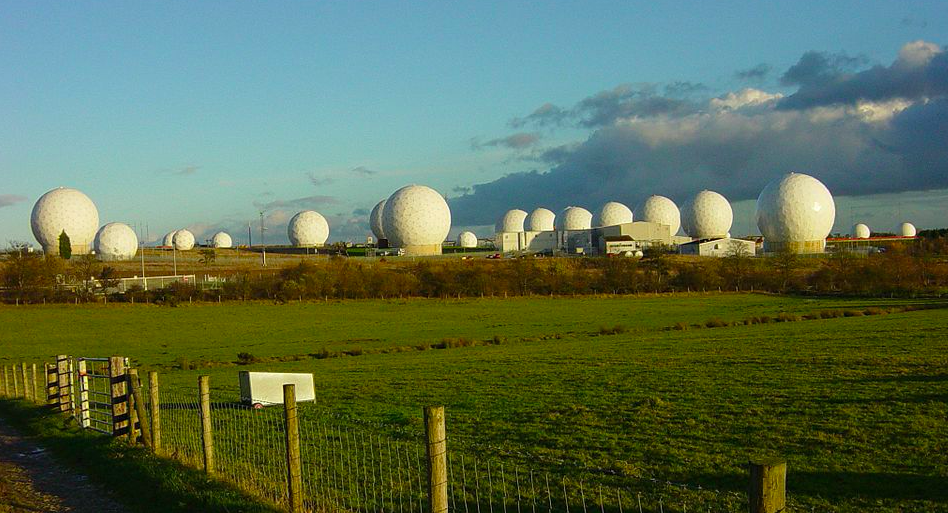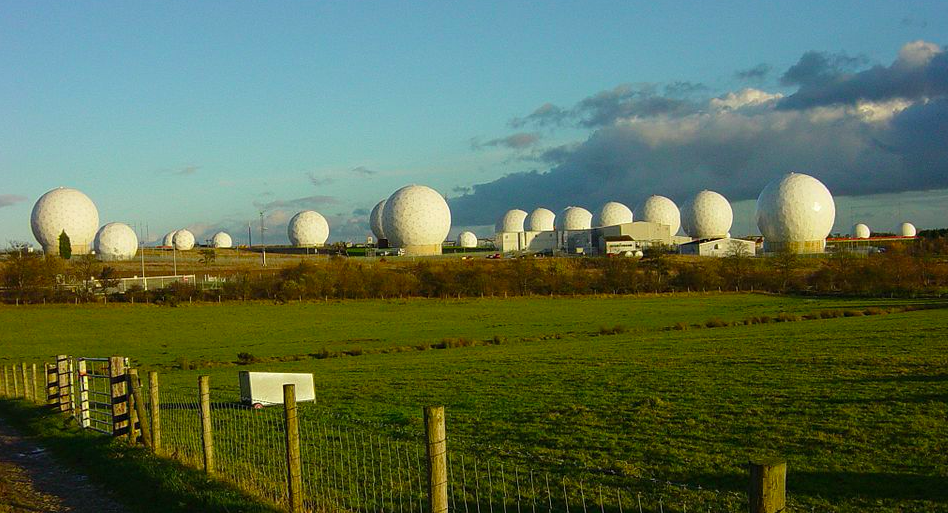
[Inside the Five Eyes series: Part 1 |Part 2 | Part 3 is below]
The technological assets that the Five Eyes can bring to bear on surveillance activities are astonishingly powerful.
The Five Eyes have added approximately 130 advanced quasi-parabolic multibeam antennas since 1995, according to a 2015 report by the Nautilus Institute, a diversely funded think tank in Australia. Each of these antennae can intercept up to 35 satellite communications beams. The Pine Gap facility alone has 38 radomes, or covered antennae, pulling down data from satellite transmissions.
The largest Five Eyes signals collection station, called Menwith Hill, is located in northern England. “Like a moon base hidden in the rolling Yorkshire hills, the station’s 33 giant golf-ball-like radomes house parabolic antennas capable of 2 million intercepts an hour from communications satellites,” wrote NSA historian James Bamford in Foreign Policy. “To better analyze data at the post, in 2012, the NSA added powerful supercomputers and boosted personnel from 1,800 to 2,500.”
Britain’s capacity to tap into the cables that carry the world’s communications cables –- referred to in the Snowden documents as “special source exploitation–- has made GCHQ an intelligence superpower, at least according to the British. In 2010, GCHQ boasted it had the “biggest internet access” of any member of the Five Eyes, according to The Guardian.
Pine Gap is the second largest Five Eyes listening post. A joint investigation in 2017 by The Intercept and the Australian Broadcasting Company found Pine Gap was the command post for at least two spy satellites that provided “continuous coverage of the majority of the Eurasian landmass and Africa.” This operation was then upgraded to “a four-satellite constellation” and covered the former Soviet Union, China, South Asia, East Asia, the Middle East, Eastern Europe, and territories in the Atlantic Ocean.

The satellites gathered “strategic and tactical military, scientific, political, and economic communications signals,” according the Snowden documents. They also “keep tabs on missile or weapons tests in targeted countries, sweep up intelligence from foreign military data systems, and provide surveillance support to U.S. forces.”
The GCHQ operates a major collection site, code named SOUNDER, on the island of Cyprus in the Mediterranean. According to the Nautilus Institute, the Cyprus facility provides high-frequency collection for Five Eyes’ global radio interception system and data for a geolocation network, code named BORESIGHT. The GCHQ also operates a remote VHF, UHF and space collection site in Cyprus which receives U.S. Air Force over-the-horizon radar signals.
The Five Eyes sifts through this ocean of data to select its surveillance targets. In 2003, the allies adopted MAINWAY, a system that used “phone call contact chaining to identify targets of interest,” according to one of the Snowden documents.
In 2004 the Five Eyes began providing cryptanalytic support for the first time to law enforcement agencies in all five countries, including the FBI and the Royal Canadian Mounted Police. It is safe to assume that the Five Eyes assist domestic law enforcement agencies to break through encryption and other technical security measure in their investigations.
Richard Tanter, a professor of security studies at the University of Melbourne and co-author of the Nautilus Institute report, says Pine Gap “remains the CIA’s most important technical intelligence collection station in the world,” controlling the agency’s satellites. The Snowden documents, he wrote, “provide authoritative confirmation that Pine Gap is involved, for example, in the geolocation of cell phones used by people throughout the world, from the Pacific to the edge of Africa.”
These efforts continue today. In 2019 a top GCHQ official proposed a so-called “ghost protocol” to enable eavesdropping on encrypted chat services as way of fighting terrorism. More than 50 tech companies, civil society organizations and security experts – including Apple, What’s App, and Privacy International signed an open letter denouncing the proposal as a threat to digital security and human rights.
Part 4: The Five Eyes and the Trump-Russia Investigation
Pine Gap: The Netflix Series



